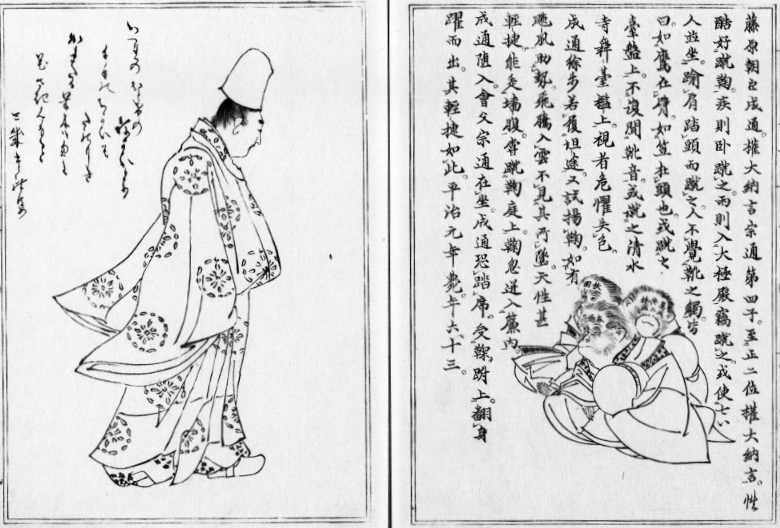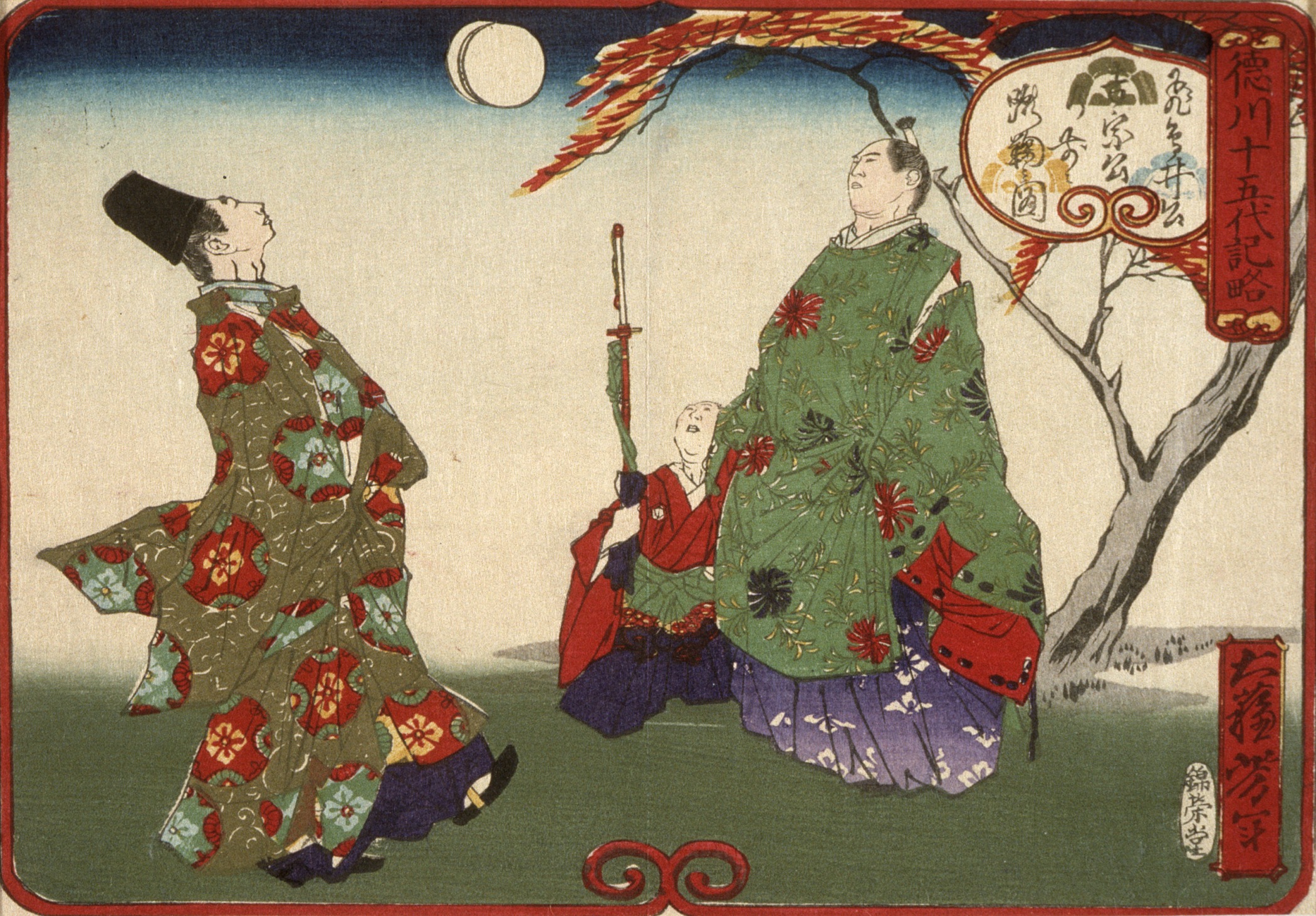Kemari on:
[Wikipedia]
[Google]
[Amazon]


 is an athletic game that was popular in
is an athletic game that was popular in


 is an athletic game that was popular in
is an athletic game that was popular in Japan
Japan ( ja, 日本, or , and formally , ''Nihonkoku'') is an island country in East Asia. It is situated in the northwest Pacific Ocean, and is bordered on the west by the Sea of Japan, while extending from the Sea of Okhotsk in the n ...
during the Heian The Japanese word Heian (平安, lit. "peace") may refer to:
* Heian period, an era of Japanese history
* Heian-kyō, the Heian-period capital of Japan that has become the present-day city of Kyoto
* Heian series, a group of karate kata (forms)
* ...
(794–1185) and Kamakura period
The is a period of Japanese history that marks the governance by the Kamakura shogunate, officially established in 1192 in Kamakura by the first ''shōgun'' Minamoto no Yoritomo after the conclusion of the Genpei War, which saw the struggle b ...
(1185–1333). It resembles a game of football or hacky sack. The game was popular in Kyoto
Kyoto (; Japanese: , ''Kyōto'' ), officially , is the capital city of Kyoto Prefecture in Japan. Located in the Kansai region on the island of Honshu, Kyoto forms a part of the Keihanshin metropolitan area along with Osaka and Kobe. , the c ...
, the capital, and the surrounding Kinki ( Kansai region), and over time it spread from the aristocracy to the samurai
were the hereditary military nobility and officer caste of medieval and early-modern Japan from the late 12th century until their abolition in 1876. They were the well-paid retainers of the '' daimyo'' (the great feudal landholders). They ...
class and '' chōnin'' class. Nowadays, ''kemari'' is played as a seasonal event mainly at Shinto shrines
A is a structure whose main purpose is to house ("enshrine") one or more '' kami'', the deities of the Shinto religion.
Overview
Structurally, a Shinto shrine typically comprises several buildings.
The ''honden''Also called (本殿, meani ...
in the Kansai region, and players play in a costume called ''kariginu'' ( :ja:狩衣), which was worn as everyday clothing by court nobles during the Heian period.
History
The earliest ''kemari'' was created under the influence of the Chinese sport '' Cuju'', which has the samekanji
are the logographic Chinese characters taken from the Chinese script and used in the writing of Japanese. They were made a major part of the Japanese writing system during the time of Old Japanese and are still used, along with the subsequ ...
. It is often said that the earliest evidence of ''kemari'' is the record of 644 CE in the '' Nihon Shoki'', but this theory is disputed. In 644, Prince Naka-no-Ōe
, also known as Emperor Tenchi, was the 38th emperor of Japan,Imperial Household Agency (''Kunaichō'')天智天皇 (38)/ref> according to the traditional order of succession.Ponsonby-Fane, Richard. (1959). ''The Imperial House of Japan'', p. 52 ...
and Nakatomi no Kamatari, who later initiated the Taika Reforms
The were a set of doctrines established by Emperor Kōtoku (孝徳天皇 ''Kōtoku tennō'') in the year 645. They were written shortly after the death of Prince Shōtoku and the defeat of the Soga clan (蘇我氏 ''Soga no uji''), uniting Ja ...
, became friends during a ball game described as "打鞠", but it may have been a hockey-like ball game using a cane instead of ''kemari''. The earliest reliable documentary evidence of the word ''kemari'' (蹴鞠) is found in a record of an annual event called ''Honchō gatsuryo'' ( :ja:本朝月令) written in the middle of the Heian period. According to the records, a ''kemari'' games were played in May 701.
''Kemari'' became popular as a game for the nobility in the late Heian period
The is the last division of classical Japanese history, running from 794 to 1185. It followed the Nara period, beginning when the 50th emperor, Emperor Kanmu, moved the capital of Japan to Heian-kyō (modern Kyoto). means "peace" in Japan ...
(794–1185) in the 11th century, and in the 12th century, Fujiwara no Narimichi ( :ja:藤原成通) and Nanba Yorisuke ( :ja:難波頼輔) gained fame as masters of ''kemari''. Fujiwara no Narimichi had made more than 50 visits to the Kumano Hongū Taisha
is a Shinto shrine located in Tanabe, Wakayama, deep in the rugged mountains of the Kii Peninsula of Japan. It is included as part of the Kumano Sanzan in the World Heritage Site "[ acred Sites and Pilgrimage Routes in the Kii Mountain Range". ...
to pray that his ''kemari'' skills would improve, and he had performed the ''kemari'' feat known as a ''ushiro mari'' (後ろ鞠, backward ball) in front of the shrine where Susanoo was enshrined. This technique is a keepie uppie performed on the heel.
It reached its peak between the end of the 12th century and around the 13th century in the early Kamakura period
The is a period of Japanese history that marks the governance by the Kamakura shogunate, officially established in 1192 in Kamakura by the first ''shōgun'' Minamoto no Yoritomo after the conclusion of the Genpei War, which saw the struggle b ...
(1185–1333), and ''kemari'' games were often played during the reign of Minamoto no Yoriie. This led to the establishment of a variety of new rules, equipment and techniques, and the completion of a structured art form called ''kemaridō'' (蹴鞠道). In the Kamakura period, ''kemari'' became popular among the samurai
were the hereditary military nobility and officer caste of medieval and early-modern Japan from the late 12th century until their abolition in 1876. They were the well-paid retainers of the '' daimyo'' (the great feudal landholders). They ...
class, and in the Muromachi period
The is a division of Japanese history running from approximately 1336 to 1573. The period marks the governance of the Muromachi or Ashikaga shogunate (''Muromachi bakufu'' or ''Ashikaga bakufu''), which was officially established in 1338 by ...
(1336–1573), ''kemari'', along with various other performing arts such as '' waka'' (Japanese poetry) and the Japanese tea ceremony, was regarded as one of the art forms that the samurai class was encouraged to master.
In the Sengoku period
The was a period in History of Japan, Japanese history of near-constant civil war and social upheaval from 1467 to 1615.
The Sengoku period was initiated by the Ōnin War in 1467 which collapsed the Feudalism, feudal system of Japan under the ...
(1467–1615), sumo became popular and ''kemari'' declined, but in the Edo period
The or is the period between 1603 and 1867 in the history of Japan, when Japan was under the rule of the Tokugawa shogunate and the country's 300 regional '' daimyo''. Emerging from the chaos of the Sengoku period, the Edo period was character ...
(16803–1868) it became popular again as a game played by '' chōnin'' class in the Kinai (Kansai region).
In the past, aristocrats living in Kyoto
Kyoto (; Japanese: , ''Kyōto'' ), officially , is the capital city of Kyoto Prefecture in Japan. Located in the Kansai region on the island of Honshu, Kyoto forms a part of the Keihanshin metropolitan area along with Osaka and Kobe. , the c ...
used to play ''kemari'' as an annual event on New Year's Day, January 4. Emperor Meiji feared that the rapid modernization of Japan would lead to the loss of various traditional Japanese cultures, and in 1903, an association was established to preserve ''kemari'' by contributing an imperial grant. Today, ''kemari'' is performed as a seasonal event in Shinto shrines
A is a structure whose main purpose is to house ("enshrine") one or more '' kami'', the deities of the Shinto religion.
Overview
Structurally, a Shinto shrine typically comprises several buildings.
The ''honden''Also called (本殿, meani ...
around the Kansai region such as Shimogamo Shrine, Shiramine Shrine
is a role-playing video game developed by Konami Computer Entertainment Tokyo and published by Konami exclusively for the PlayStation 2 video game console and is the fourth installment of the '' Suikoden'' video game series. It was released in ...
, Fujimori Shrine ( :ja:藤森神社), Tanzan Shrine, Hirano Shrine and Kotohira-gū. Seidaimyōjin (精大明神), enshrined as one of the sessha (auxiliary shrine) of Shiramine Shrine, is the kami
are the deities, divinities, spirits, phenomena or "holy powers", that are venerated in the Shinto religion. They can be elements of the landscape, forces of nature, or beings and the qualities that these beings express; they can also be the sp ...
of the ''mari'' (''kemari'' ball) and is therefore respected by players of various ball games, mainly association football
Association football, more commonly known as football or soccer, is a team sport played between two teams of 11 players who primarily use their feet to propel the ball around a rectangular field called a pitch. The objective of the game is ...
.
George H. W. Bush played the game on one of his presidential visits to Japan.
Description
It is a non-competitive sport. The object of Kemari is to keep one ball in the air, with all players cooperating to do so. Players may use any body part with the exception of arms and hands – their head, feet, knees, back, and depending on the rules, elbows to keep the ball aloft. The ball, known as a ''mari'', is made of deerskin with the hair facing inside and the hide on the outside. The ball is stuffed with barley grains to give it shape. When the hide has set in this shape, the grains are removed from the ball, and it is then sewn together using the skin of a horse. The one who kicks the ball is called a ''mariashi.'' A good mariashi makes it easy for the receiver to control the mari, and serves it with a soft touch to make it easy to keep the mari in the air. ''Kemari'' is played on a flat ground, about 6–7 meters squared. The uniforms that the modern players wear are reminiscent of the clothes of the Heian period and include a crow hat. This type of clothing was called ''kariginu'' ( :ja:狩衣) and it was fashionable at that time.See also
* Mari (Noh play)References
External links
* https://www.youtube.com/watch?v=UO3vRH2z8jo {{Authority control Heian period Ball games Sport in Japan Traditional football